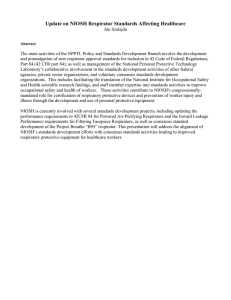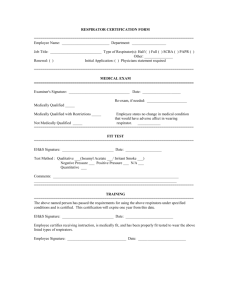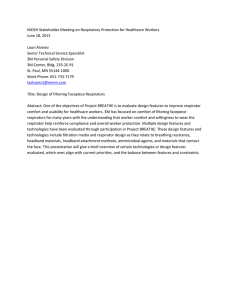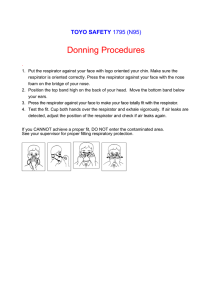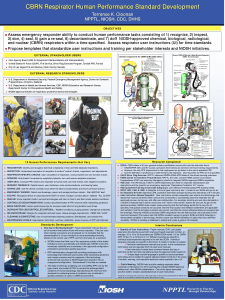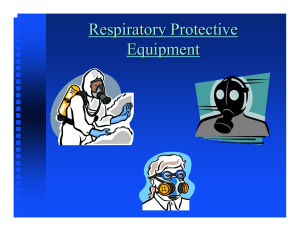Chemical, Biological, Radiological and Nuclear Combination Respirator
advertisement
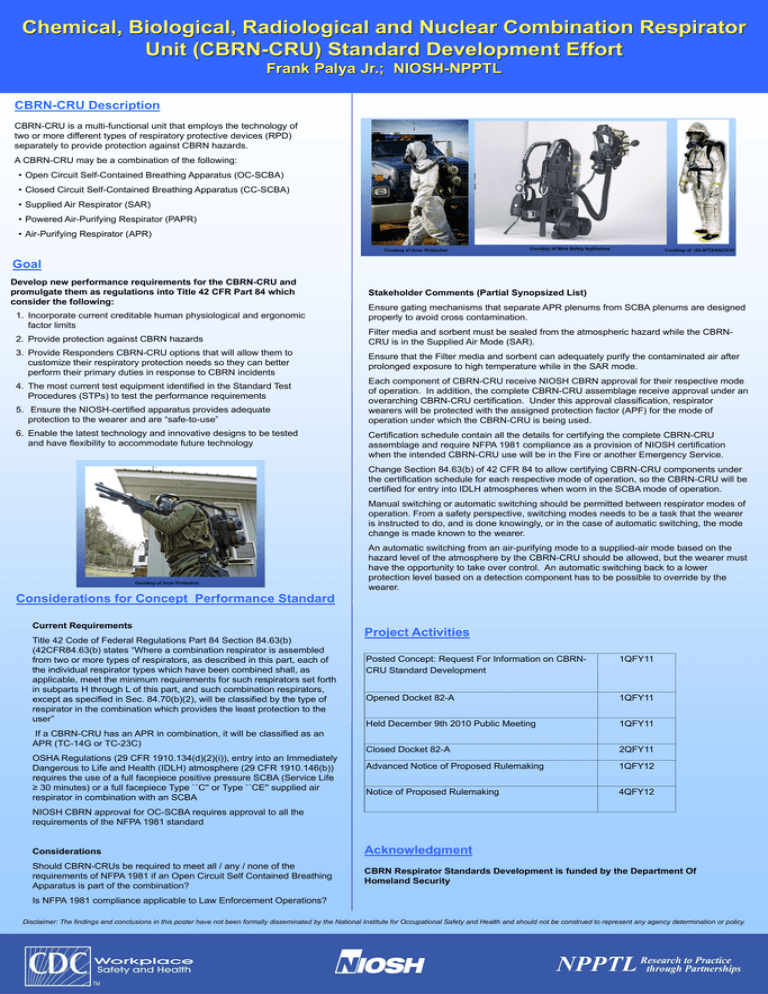
Chemical, Biological, Radiological and Nuclear Combination Respirator Unit (CBRN-CRU) Standard Development Effort Frank Palya Jr.; NIOSH-NPPTL CBRN-CRU Description CBRN-CRU is a multi-functional unit that employs the technology of two or more different types of respiratory protective devices (RPD) separately to provide protection against CBRN hazards. A CBRN-CRU may be a combination of the following: • Open Circuit Self-Contained Breathing Apparatus (OC-SCBA) • Closed Circuit Self-Contained Breathing Apparatus (CC-SCBA) • Supplied Air Respirator (SAR) • Powered Air-Purifying Respirator (PAPR) • Air-Purifying Respirator (APR) Courtesy of Avon Protection Courtesy of Mine Safety Appliances Courtesy of HQ AFCESA/CEXF Goal Develop new performance requirements for the CBRN-CRU and promulgate them as regulations into Title 42 CFR Part 84 which consider the following: 1. Incorporate current creditable human physiological and ergonomic factor limits Stakeholder Comments (Partial Synopsized List) Ensure gating mechanisms that separate APR plenums from SCBA plenums are designed properly to avoid cross contamination. 2. Provide protection against CBRN hazards Filter media and sorbent must be sealed from the atmospheric hazard while the CBRNCRU is in the Supplied Air Mode (SAR). 3. Provide Responders CBRN-CRU options that will allow them to customize their respiratory protection needs so they can better perform their primary duties in response to CBRN incidents Ensure that the Filter media and sorbent can adequately purify the contaminated air after prolonged exposure to high temperature while in the SAR mode. 4. The most current test equipment identified in the Standard Test Procedures (STPs) to test the performance requirements 5. Ensure the NIOSH-certified apparatus provides adequate protection to the wearer and are “safe-to-use” 6. Enable the latest technology and innovative designs to be tested and have flexibility to accommodate future technology Each component of CBRN-CRU receive NIOSH CBRN approval for their respective mode of operation. In addition, the complete CBRN-CRU assemblage receive approval under an overarching CBRN-CRU certification. Under this approval classification, respirator wearers will be protected with the assigned protection factor (APF) for the mode of operation under which the CBRN-CRU is being used. Certification schedule contain all the details for certifying the complete CBRN-CRU assemblage and require NFPA 1981 compliance as a provision of NIOSH certification when the intended CBRN-CRU use will be in the Fire or another Emergency Service. Change Section 84.63(b) of 42 CFR 84 to allow certifying CBRN-CRU components under the certification schedule for each respective mode of operation, so the CBRN-CRU will be certified for entry into IDLH atmospheres when worn in the SCBA mode of operation. Manual switching or automatic switching should be permitted between respirator modes of operation. From a safety perspective, switching modes needs to be a task that the wearer is instructed to do, and is done knowingly, or in the case of automatic switching, the mode change is made known to the wearer. Courtesy of Avon Protection An automatic switching from an air-purifying mode to a supplied-air mode based on the hazard level of the atmosphere by the CBRN-CRU should be allowed, but the wearer must have the opportunity to take over control. An automatic switching back to a lower protection level based on a detection component has to be possible to override by the wearer. Considerations for Concept Performance Standard Current Requirements Title 42 Code of Federal Regulations Part 84 Section 84.63(b) (42CFR84.63(b) states “Where a combination respirator is assembled from two or more types of respirators, as described in this part, each of the individual respirator types which have been combined shall, as applicable, meet the minimum requirements for such respirators set forth in subparts H through L of this part, and such combination respirators, except as specified in Sec. 84.70(b)(2), will be classified by the type of respirator in the combination which provides the least protection to the user” If a CBRN-CRU has an APR in combination, it will be classified as an APR (TC-14G or TC-23C) OSHA Regulations (29 CFR 1910.134(d)(2)(i)), entry into an Immediately Dangerous to Life and Health (IDLH) atmosphere (29 CFR 1910.146(b)) requires the use of a full facepiece positive pressure SCBA (Service Life ≥ 30 minutes) or a full facepiece Type ``C'' or Type ``CE'' supplied air respirator in combination with an SCBA Project Activities Posted Concept: Request For Information on CBRNCRU Standard Development 1QFY11 Opened Docket 82-A 1QFY11 Held December 9th 2010 Public Meeting 1QFY11 Closed Docket 82-A 2QFY11 Advanced Notice of Proposed Rulemaking 1QFY12 Notice of Proposed Rulemaking 4QFY12 NIOSH CBRN approval for OC-SCBA requires approval to all the requirements of the NFPA 1981 standard Considerations Acknowledgment Should CBRN-CRUs be required to meet all / any / none of the requirements of NFPA 1981 if an Open Circuit Self Contained Breathing Apparatus is part of the combination? CBRN Respirator Standards Development is funded by the Department Of Homeland Security Is NFPA 1981 compliance applicable to Law Enforcement Operations? Disclaimer: The findings and conclusions in this poster have not been formally disseminated by the National Institute for Occupational Safety and Health and should not be construed to represent any agency determination or policy.

